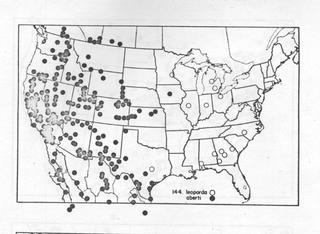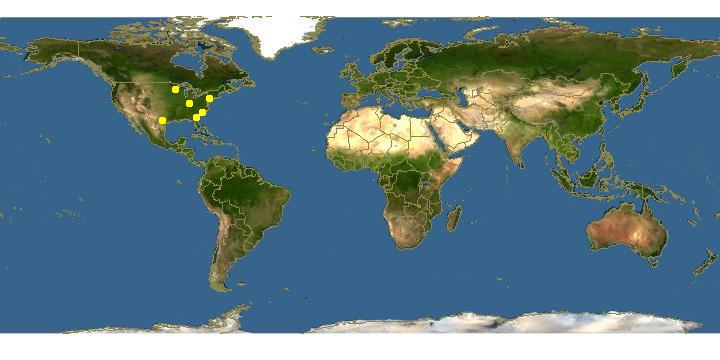
Arnold S. E. Menke, 1965 · 1
Ammophila leoparda, and others, map |

Click on map for details about points.
|
|
Overview |
Taken from: A Revision of the North American Ammophila (hymenoptera, Sphecidae). Arnold S. E. Menke, 1965.
Ammophila (Ammophila) leoparda (Fernald)
(Figs. 48, 62, 144)
Sphex urnarius leopardus Fernald, 1934. North American West Indian digger wasps genus Sphex, p. 125. Holotype female, Georgia (United States National Museum, Washington).
Male. Average length 15.5 mm., range: 15-17mm.
Color. Black; tegula brownish posteriorly; pronotal lobe, pronotal side occasionally, metapleural flange, and sometimes gastral segment I, red; wings clear or slightly infumate, veins brown to black.
Vestiture. Gena without appressed silver hair; mesopleuron with a band of appressed silver hair along mesopleural suture from base of midcoxa to bottom of hypoepimeral area, sometimes weakly to top of hypoepimeral area; inferior metapleural area near base of hind coxa with a patch of appressed silver hair, hair continuing along metapleural sulcus as a band, ending near superior metapleural pit.
Structure. Labrum rounded; collar, scutum, mesopleuron, inferior metapleural area and propodeal side densely micropunctate, moderately to densely macropunctate, macropunctures large; scutellum coarsely punctate, ridged; metapleural flange broadly lamellate, width nearly twice peritreme diameter, outer margin excised (fig. 62); right penis valve similar to figures 128-129.
Female. Avenge length 17 mm., range: 16.5-17.5 mm.
Color. As in male except entire pleural region and petiole often red; tegula and gastral segment I usually red.
Vestiture. As in male except gena with appressed silver hair.
Structure. Labrum rounded; clypeal disk slightly, broadly arched, densely micropunctate, densely macropunctate, median free margin not produced, lamelliform laterally, teeth absent (fig. 48); inner orbits moderately converging below, LID:GID (73:104),
Range (fig. 144). Apparently, Ammophila leoparda occurs over much of the eastern half of the United States but judging by the scarcity of specimens in collections the species must occupy restricted habitats.
Material examined. (8 males,. 10 females, May to September). ALABAMA, Lee Co.: Auburn, on Cyanotis (CUI). Washington Co.: Leroy (CUI). GEORGIA, Crawford Co.: Roberta (USUM). Dooley Co.: Unadilla (CUI). Early Co.: Spring Creek (CUI). Richmond Co.: Fort Gordon (CIS, LACM). ILLINOIS, Mason Co.; Havana (AMNH). INDIANA, Co.?, Mineral Springs (CAS). MICHIGAN, Livingston Co.: E. S. George Reserve (USNM). Midland Co.: “Midland Co.” (UCD). MINNESOTA, Washington Co,: “Washington Co.” (UMSP, USNM). NORTH CAROLINA, Moore Co.: Southern Pines (AMNH). TEXAS Bastrop .: McDade (UKL).
Murray (1938) listed material from the following localities: MINNESOTA, Barden (UMSP). Fort Snelling (UMSP), OHIO, Sandusky Co: Clyde (UMSP).
Variation. Color is the only feature which varies to any significant degree in leoparda, and this has been covered in the description.
Systematics. The very broad metapleural flange and red mesosomal areas make leoparda one of the most distinctive members of the urnaria group.
Ammophila urnaria Group
Diagnosis. Primary characters: Free margin of male clypeus emarginate (except in aberti and bellula) hypostoma in male simple, without a process (fig. 29); collar and scutum usually without strong transverse ridges (except in cleopatra) propodeal enclosure irregularly rugose medially, diagonally ridged laterally, interspaces smooth and/or punctate, subshining to shining, or sometimes minutely etched, dull (fig. 22); preepisternal sulcus short, ending about opposite pronotal lobe; metapleural flange not lamellate (except in leoparda, kennedyi sometimes, and aberti rarely); spine-like process of penis valve head basal, generally directed toward base of penis valve stalk (except in bellula) (rigs. 122-225, 127- 129); base of gonoforceps not dorsoventrally elongate. Secondary characters : Clypeus and frons with appressed silver hair (except kennedyi and urnaria females), male clypeus usually completely covered by appressed hair, obscuring underlying sculpture (except kennedyi, picipes and some urnaria), female clypeus glabrous anteromedially; pronotal lobe and propodeum adjacent to petiole socket covered with appressed silver hair (lobe of female urnaria with dense hair only posteriorly); erect body hair pale; psammophore pale (sometimes partially brownish in dysmica, juncea, kennedyi, picipes and urnaria) length of flagellomere I in male less than least interocular distance and greater than length of flagellomere II; middle tibia with two veil developed apical spurs (except in some aberti and dysmica) forewing with three submarginal cells.
Included North American species. Ammophila aberti Haldeman, bellula Menke, cleopatra Menke, dysmica Menke, hermosa Menke, juncea Cresson, kennedyi (Murray), leoparda (Fernald), mescalero Menke, parkeri Menke, picipes Cameron and urnaria Dahlbom. Other New World species belonging to the urnaria group but not dealt with in this paper are: A. dejecta Cameron (Mexico), gracilis Lepeletier, lampei Strand, rufipes Guérin-Méneville, and suavis Burmeister (all South American).
Discussion. The urnaria group is a difficult one because most of the species are very similar. Also, the male genitalia display specific differences only in a few species, aberti, bellula and kennedyi. The penis valve head of urnaria is quite variable (figs. 128-129) and the following species have aedeagi of the same general configuration: cleopatra, dysmica, hermosa, juncea, leoparda, mescalero, parkeri and picipes. Of prime importance for species discrimination in the urnaria group ii the pattern of appressed hair on the mesosoma, particularly the pleural region. Unfortunately, old or worn specimens make hair patterns difficult to use, and often it is impossible to identify material in this condition without a thorough knowledge of the group. Some species have characteristic markings on the abdomen and a few have bicolored legs or other chromatic peculiarities. Structurally the urnaria group is fairly homogeneous with nearly all species having similar punctation etc. Some differences are found in the shape of the labrum but here also there is variability. Clypeal structure is sometimes distinctive but it is difficult to describe. The possibility of using various head measurements in species diagnosis has not been fully explored in the urnaria group. Comparisons of the lengths of flagellomeres I and II and also of the least interocular distance versus the length of flagellomere I seem to have no value, at least for the distinction of difficult species. Other measurements might be made in search of better species criteria: overall head width, eye width, length of head and degree of eye convergence, for example.
The six species that are the most difficult to identity can be divided into two groups of black-legged species. In one group, the mesopleural band of appressed hair ends at the bottom of the hypoepimeral area (dysmica, kennedyi and urnaria). In the second group the band extends to the top of the hypoepimeral area juncea, and picipes). A few species in the urnaria group seem to have no close allies: Ammophila aberti, bellula, leoparda and mescalero.
The arvensis group proposed by Fernald (1934) contained species belonging to the urnaria group and the azteca group. Fernald’s concept included pilosa (Fernald) (= azteca Cameron), arvensis Dahlbom (an Old World name used in error for mediata Cresson, evansi Menke and possibly other species), floridensis (Fernald) (= urnaria Dahlbom), urnaria Dahlbom (Fernald confused kennedyi and possibly other species with urnaria), and leoparda (Fernald) as variety of urnaria). The similar pleural pubescence pattern exhibited by these species was apparently the only criterion used by Fernald for this unnatural assumblage of species.
The urnaria group is represented throughout the New World, but appears to have no Old World allies.
|
|
|
Names | |
|
|
| Supported by | |
Updated: 2024-05-04 12:06:32 gmt
|